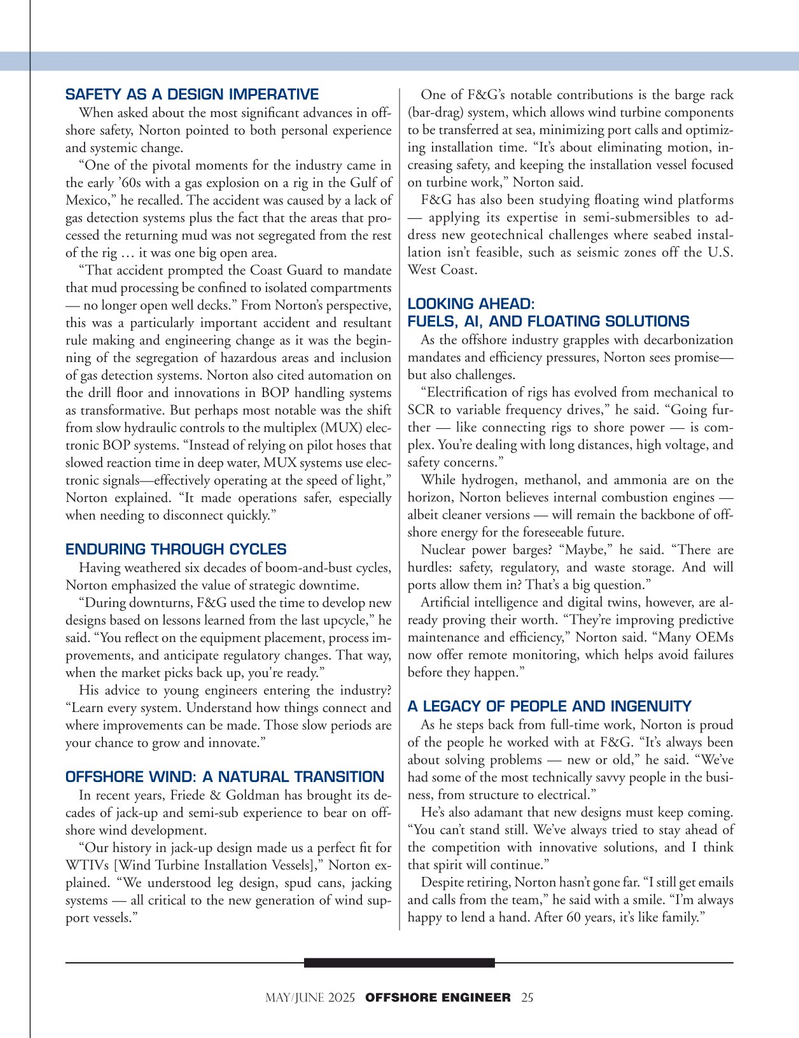
Page 25: of Offshore Engineer Magazine (May/Jun 2025)
Read this page in Pdf, Flash or Html5 edition of May/Jun 2025 Offshore Engineer Magazine
SAFETY AS A DESIGN IMPERATIVE One of F&G’s notable contributions is the barge rack
When asked about the most signifcant advances in off- (bar-drag) system, which allows wind turbine components shore safety, Norton pointed to both personal experience to be transferred at sea, minimizing port calls and optimiz- and systemic change. ing installation time. “It’s about eliminating motion, in- “One of the pivotal moments for the industry came in creasing safety, and keeping the installation vessel focused the early ’60s with a gas explosion on a rig in the Gulf of on turbine work,” Norton said.
Mexico,” he recalled. The accident was caused by a lack of F&G has also been studying foating wind platforms gas detection systems plus the fact that the areas that pro- — applying its expertise in semi-submersibles to ad- cessed the returning mud was not segregated from the rest dress new geotechnical challenges where seabed instal- of the rig … it was one big open area. lation isn’t feasible, such as seismic zones off the U.S. “That accident prompted the Coast Guard to mandate West Coast.
that mud processing be confned to isolated compartments — no longer open well decks.” From Norton’s perspective, LOOKING AHEAD: this was a particularly important accident and resultant FUELS, AI, AND FLOATING SOLUTIONS rule making and engineering change as it was the begin- As the offshore industry grapples with decarbonization ning of the segregation of hazardous areas and inclusion mandates and effciency pressures, Norton sees promise— of gas detection systems. Norton also cited automation on but also challenges.
the drill foor and innovations in BOP handling systems “Electrifcation of rigs has evolved from mechanical to as transformative. But perhaps most notable was the shift SCR to variable frequency drives,” he said. “Going fur- from slow hydraulic controls to the multiplex (MUX) elec- ther — like connecting rigs to shore power — is com- tronic BOP systems. “Instead of relying on pilot hoses that plex. You’re dealing with long distances, high voltage, and slowed reaction time in deep water, MUX systems use elec- safety concerns.” tronic signals—effectively operating at the speed of light,” While hydrogen, methanol, and ammonia are on the
Norton explained. “It made operations safer, especially horizon, Norton believes internal combustion engines — when needing to disconnect quickly.” albeit cleaner versions — will remain the backbone of off- shore energy for the foreseeable future.
ENDURING THROUGH CYCLES Nuclear power barges? “Maybe,” he said. “There are
Having weathered six decades of boom-and-bust cycles, hurdles: safety, regulatory, and waste storage. And will
Norton emphasized the value of strategic downtime. ports allow them in? That’s a big question.” “During downturns, F&G used the time to develop new Artifcial intelligence and digital twins, however, are al- designs based on lessons learned from the last upcycle,” he ready proving their worth. “They’re improving predictive said. “You refect on the equipment placement, process im- maintenance and effciency,” Norton said. “Many OEMs provements, and anticipate regulatory changes. That way, now offer remote monitoring, which helps avoid failures when the market picks back up, you're ready.” before they happen.”
His advice to young engineers entering the industry? “Learn every system. Understand how things connect and A LEGACY OF PEOPLE AND INGENUITY where improvements can be made. Those slow periods are As he steps back from full-time work, Norton is proud your chance to grow and innovate.” of the people he worked with at F&G. “It’s always been about solving problems — new or old,” he said. “We’ve
OFFSHORE WIND: A NATURAL TRANSITION had some of the most technically savvy people in the busi-
In recent years, Friede & Goldman has brought its de- ness, from structure to electrical.” cades of jack-up and semi-sub experience to bear on off- He’s also adamant that new designs must keep coming. shore wind development. “You can’t stand still. We’ve always tried to stay ahead of “Our history in jack-up design made us a perfect ft for the competition with innovative solutions, and I think
WTIVs [Wind Turbine Installation Vessels],” Norton ex- that spirit will continue.” plained. “We understood leg design, spud cans, jacking Despite retiring, Norton hasn’t gone far. “I still get emails systems — all critical to the new generation of wind sup- and calls from the team,” he said with a smile. “I’m always port vessels.” happy to lend a hand. After 60 years, it’s like family.”
MAY/JUNE 2025 OFFSHORE ENGINEER 25

 24
24

 26
26